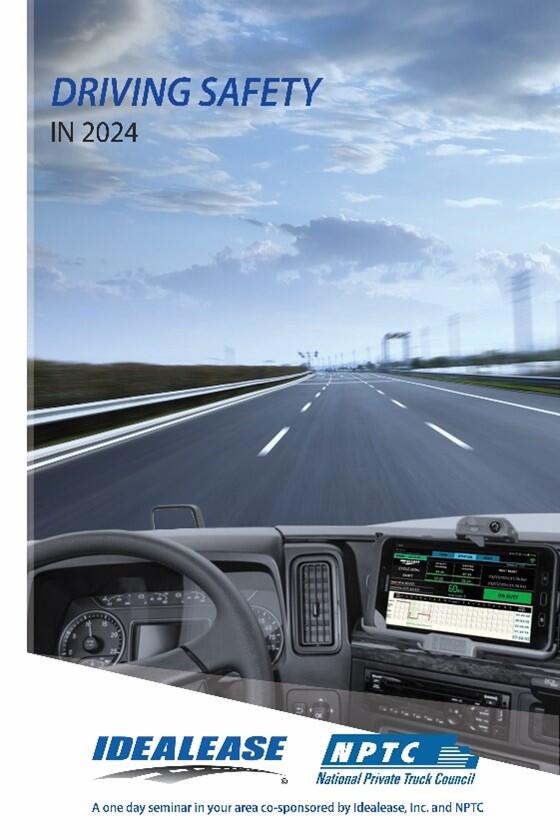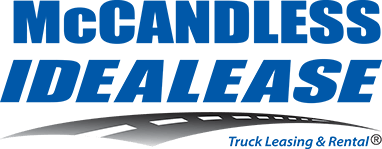Do You Have a Career Path For Your Employees?
This week's Safety Bulletin we dives into the importance of cultivating a career path for your employees! Read the full safety bulletin here and subscribe to receive future safety bulletins straight to your inbox.
In this issue:
- Overhead Damage: How to Avoid Turning Your Truck or Trailer into a Convertible
- DOT Postpones Motor Carrier Rulemakings
- Registration Now Open for the 2024 Idealease/NPTC Safety Seminars!
- FMCSA Proposes Changes to Enhance Flexibility in CDL Program
- February: Heart Protection Month
Our industry continues to grapple with the challenge of recruiting enough drivers and technicians to service and operate trucks. When was the last time you heard a young boy or girl say, "When I grow up, I want to be a truck driver or truck technician?" It's a rarity. Nearly every week, someone asks me how to attract new drivers and technicians. I immediately respond, "What are you doing to retain the skilled drivers and technicians you already have?" Focus on retaining your employees; rest assured someone else is actively recruiting them from you.
There's no single solution to driver and technician retention, but there are proven methods you can implement to reduce turnover. One effective strategy is establishing a clear career path for all your employees. Another term often used is a driver or technician elevation program. Without a clear vision of what they can achieve within your company, employees will likely lose motivation and eventually seek opportunities elsewhere. Both drivers and technicians are willing to leave a company for a slightly higher pay rate.
I suggest tying training and pay increases together. At our Atlanta facility, we've implemented a career path program where pay increases are linked to the training a technician completes. Technicians can boost their pay by completing training modules and passing exams. This approach has proven beneficial for both the employer and the employee. We benefit from highly skilled technicians who efficiently repair and service our units, reducing turnover and fewer comeback repairs.
Technicians can increase their pay and advance their careers through education. Just imagine the potential savings if all employees were at the highest level of education and pay!
Overhead Damage: How to Avoid Turning Your Truck or Trailer into a Convertible
Prevent overhead damage accidents and spare your vehicle from costly repairs to its roof, sides, front, and rear. Here are some tips for drivers to prevent this type of damage:
- Customer Directions: When calling your customer for directions to their facility, remember that the person giving you directions likely drives there daily in a car. They may not consider the height restrictions for trucks. Specifically, ask if the directions are on a truck route and inquire about low clearances.
- Stay Alert: Pay attention to overhead clearances posted before underpasses, bridges, and tunnels. New road construction, like fresh asphalt, can alter clearances, so remain vigilant.
- Don't Follow the Crowd: Just because other trucks pass under a bridge doesn't guarantee you'll fit. If an overpass looks low, slow down immediately and check your clearance before proceeding.
- Inside Lane Advantage: Many bridges and overpasses are not perfectly straight, with lower sides than the center. Cross under in the inside lane to maximize clearance.
- Watch the Road: Check the road elevation on the other side of the bridge for sharp inclines or declines. Exiting a bridge with a steep road elevation can cause damage as your vehicle's body or trailer may be driven up into the bridge.
- Weather Conditions: In winter, snow, and ice on the roadway can alter clearance, potentially causing damage. Stay cautious and adjust your approach accordingly.
- Seek Assistance: If you realize you can't proceed under a low overhead and traffic is congested, it's safer to call the police for assistance in backing out of the situation rather than risking an accident by backing against traffic.
Stay mindful and proactive to prevent overhead damage accidents and keep your vehicle in top condition.
DOT Postpones Motor Carrier Rulemakings
The February 2024 version of the Department of Transportation's List of Significant Rulemakings has extended the expected dates for several motor carrier rulemakings. Although the dates are not rigid or legal deadlines, the list does indicate the department's current assessment of where a specific proceeding stands in the rulemaking process.
- Speed Limiting Devices. The Federal Motor Carrier Safety Administration plans to issue a Supplemental Notice of Proposed Rulemaking in May 2024, replacing a 2016 proposed rule issued by FMCSA and the National Highway Traffic Safety Administration. The new SNPRM will consider whether motor carriers operating commercial motor vehicles in interstate commerce with a gross vehicle weight rating or gross vehicle weight of 26,001 pounds or more, whichever is greater, that are equipped with an electronic engine control unit capable of governing the maximum speed be required to limit the CMV to a speed to be determined by the rulemaking and to maintain that setting for the service life of the vehicle.
- Motor Carrier Safety Fitness Procedures. In an August 2023 Advance Notice of Proposed Rulemaking, FMCSA sought information on how to use data and resources more effectively to identify unfit motor carriers and remove them from operating CMVs. FMCSA asked for information about using available safety data, including inspection data, in determining carrier fitness to operate, possible changes to the current three-tier safety fitness rating structure, and the list of Federal Motor Carrier Safety Regulations used in its safety fitness rating methodology. The agency plans to issue a Notice of Proposed Rulemaking in June 2025.
- Automated Driving Systems. FMCSA intends to issue a Notice of Proposed Rulemaking in March 2024 to amend specific Federal Motor Carrier Safety Regulations to provide for the safe introduction of automated driving systems (ADS)-equipped commercial motor vehicles onto public roadways. The proposed changes will affect CMV operations, inspection, repair, and maintenance regulations and will recognize the difference between human operators and ADS. FMCSA held listening sessions in 2017 and published a 2018 request for comments on which regulations might be a barrier to the safe testing and use of ADS-equipped CMVs.
- Automatic Emergency Braking Systems. FMCSA and NHTSA plan to issue a Final Rule in April 2024 to require and/or standardize equipment performance for heavy trucks' automatic emergency braking (AEB) systems. The rulemaking will establish performance standards and motor carrier maintenance requirements for AEB systems on heavy trucks and accompanying test procedures for measuring the performance of the AEB systems in NHTSA compliance testing. NHTSA and FMCSA have engaged in national outreach, education, awareness campaigns, and data collection analyses, including training materials for fleets, drivers, and maintenance personnel related to AEB technology.
- Hazardous Materials Modal Safety Advancements. The Pipeline and Hazardous Materials Safety Administration plans to issue a Notice of Proposed Rulemaking in May 2024 to adopt several modal-specific amendments to enhance the safe transportation of hazardous materials. PHMSA has consulted with FMCSA, the Federal Railroad Administration, and the United States Coast Guard to propose amendments identified during departmental review and from industry petitions for rulemaking.
February: Heart Protection Month
February marks Heart Protection Month, a time to raise awareness about heart health and its significance, especially for commercial drivers. Below are some common questions regarding heart conditions and commercial drivers, along with detailed answers:
Question 1: Can a driver who takes nitroglycerine for angina be certified?
Answer: Yes, the use of nitroglycerine for angina is not disqualifying. However, the medical examiner may require a cardiologist to maintain the driver's angina.
Question 2: Can I drive a commercial vehicle after having angioplasty/stents inserted into my heart?
Answer: Yes, drivers who have undergone uncomplicated, elective Percutaneous Coronary Intervention (PCI), with or without stenting, to treat stable angina may return to work as soon as one week after the procedure. The criteria for return to work after PCI include:
- An examination and approval by the treating cardiologist.
- Asymptomatic status.
- No injury to the vascular access site.
- Exercise Tolerance Test (ETT) three to six months post-PCI. For CMV drivers, this requires exercising to a workload capacity of at least six METS (through Bruce Stage II or equivalent), attaining a heart rate >85% of the predicted maximum (unless on beta blockers), a rise in SBP >20mmHg without angina, and no significant ST segment depression or elevation. Stress radionuclide or echocardiography imaging should be performed for symptomatic individuals, those with an abnormal resting echocardiogram, or drivers who fail to meet the minimal standards required from the standard ETT.
- Annual medical qualification examination.
- Negative ETT at least every other year (criteria above) and tolerance of all cardiovascular medication. The driver should not experience orthostatic symptoms, including light-headedness, a resting SBP<95mmHg systolic, or a systolic blood pressure decline > 20mmHg upon standing.
Stay informed about heart health and ensure the well-being of yourself and others, especially if you're a commercial driver. If you have further questions or concerns, consult a medical professional for personalized advice and guidance.

Registration Now Open for the 2024 Idealease/NPTC Safety Seminars!
Driving Safety in 2024
Idealease and the National Private Truck Council (NPTC) are excited to announce the opening of registration for the 2024 Safety Seminars. These one-day seminars will focus on crucial topics such as safety data analysis, basic safety and compliance, regulation changes, and CSA.
Who Can Attend: These seminars are open to all Idealease customers, potential customers, and NPTC members, and are provided at no charge.
Seminar Highlights:
- Gain insights into safety practices and compliance regulations.
- Learn about the latest advancements in safety technology.
- Understand CSA (Compliance, Safety, Accountability) and its impact on your operations.
Why Attend: Whether you're a novice or experienced transportation professional, these seminars offer valuable information to enhance your safety practices.
Registration Details: Seminars are currently available for registration, with venues secured for the following locations:
- 4/10/24: Sun Prairie, WI
- 4/18/24: Frankfort, KY
- 5/9/2024: Tampa, FL
Note: If you don't see a seminar in your area listed yet, don't worry. Registration availability will be updated weekly as venues are secured. Keep an eye on this bulletin for the latest updates.
To register for an upcoming seminar in 2024, click on the following link: Safety Seminar RegistrationDon't miss out on this opportunity to enhance your safety knowledge and practices in 2024. Register today!

FMCSA Proposes Changes to Enhance Flexibility in CDL Program
The Federal Motor Carrier Safety Administration (FMCSA) has proposed a Notice of Proposed Rulemaking to enhance flexibility for State Driver Licensing Agencies (SDLAs) and commercial driver’s license (CDL) applicants. The proposal includes:
- Expanding applicants’ ability to take a CDL skills test in a State other than their domicile.
- Allowing commercial learner’s permit (CLP) holders who have passed the CDL skills test to operate a CMV on public roads without a qualified CDL holder in the passenger seat.
- Eliminating the requirement for applicants to wait at least 14 days to take the CDL skills test after receiving their CLP.
- Requiring third-party knowledge examiners to meet the same training, certification, and record check standards as State knowledge examiners, with third-party knowledge testers subject to auditing and monitoring requirements similar to those for third-party skills testers.
These proposed changes respond to petitions for rulemaking from the American Trucking Associations and the New Hampshire Department of Transportation.
